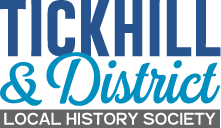

George Colbeck 1813-1897
Tailor then ironmonger and local preacher
George was the eldest child of Samuel and Anne Colbeck. He was baptised at St Mary’s on 3 March 1813. Three more siblings were born by 1819. In the baptismal records for all the children Samuel was described as a labourer. However, both Samuel and Anne were able to sign their names in the Marriage Register, only one of three couples out of the 12 couples who married at St Mary’s in 1812 where both husband and wife could do so. It is likely that George’s parents were literate and that he certainly was. He married Mary Elvidg[e] at St Mary’s on 10 December 1839 and by the time of the 1841 Census was established as a tailor with Mary and their first child John. Ten years later George was still employed as a tailor but his family had increased. He and Mary now had three sons and four daughters, all but the youngest two at school. Although listed as living in Westgate in 1851 this seems to have been an administrative convenience for the census enumerator. Looking at the 1851 census map in Tom Beastall’s ‘Tickhill: Portrait of an English Country Town’, page 147, George and his family in fact lived at the junction of St Mary’s Gate and Castlegate at what is now Teasdales the bakers.
George had changed his occupation by 1861. There were nine other tailors in Tickhill according to a Directory of 1852 and this might have meant there was insufficient work for George to support his large family. He was now an ironmonger and local preacher. Another daughter and son had also been born. He was listed in Castlegate in 1881 working as an ironmonger as was his youngest son William, aged 22. At the age of 79 in 1891 George was still an ironmonger in a hardware shop in Castlegate but no longer had his children living with him and Mary.
George became a respected member of the community in Tickhill, as these examples show. In 1854 he was classed as one of the ‘influential inhabitants’ of Tickhill who, along with the Vicar, Churchwardens and Overseers of the Poor, met on 24 February to put the governance of the Maison Dieu almshouses on a formal footing for the Charity Commissioners. On 28 July 1885, during the run up to the general election, George chaired a public meeting for two Liberal candidates: Mr W S Shirley candidate for the Doncaster parliamentary constituency, and Mr J S Leadam candidate for a Cheshire constituency. George, these two candidates and seven others were on the back of a wagon in the Market Place addressing the populace. William Shirley was duly elected as Doncaster’s MP. George’s name also appeared on lists of local people who made donations, for example, to the National and Infants’ Schools.
As a local preacher George travelled around the Doncaster Circuit based at Priory Place and periodically from 1882-4 attended meetings for local preachers in the Priory Place Chapel schoolroom. He and fellow preachers were regularly examined as to their moral and religious character, belief and preaching of Methodist doctrines, attention to discipline and ability for the work of preacher. At some stage in the late 1880s George transferred to the Oxford Place Circuit but is not recorded as attending any meetings for local preachers at Oxford Place.
On one occasion George fell foul of the law and was summoned to appear at the West Riding Police Court in November 1885 for selling fireworks to children under 13 years of age. P.C.Bellerby stated that at 7p.m. on 5 November he saw a number of children coming out of the defendant’s shop with fireworks in their hands. He then gave his 11 year old daughter 2 pence to buy some fireworks and she was served by the defendant. In his defence, George, described as an ironmonger, said it was difficult to tell how old the children were. He had no intention to sell to children but had evidently been trapped. He was found guilty, fined 5 shillings and had to pay 15 shillings costs. (Epworth Bells, Crowle & Isle of Axholme Mercury 28 November 1885).
George was buried in the churchyard on 4 April 1897 in a grave where his wife and two children were buried. On his gravestone which has now been placed flat near the footpath at the eastern end of the church there is this inscription:
The Doncaster Gazette14 May 1897 carried a letter from a reader who had expected to see an obituary in the paper following George’s death. As one had not appeared the letter noted that George was the oldest Wesleyan preacher in the Doncaster District and that he should not pass away without a tribute being paid. The letter writer had heard George preach when a boy and had known him for over 40 years. George, an esteemed local preacher, had walked miles to preach ‘for the love of trying to lift the fallen’. (Letter quoted in Donald Reasbeck (ed), Not ashamed: local preachers in Doncaster 1796-1996, Hexpress Publications, 1996, pages 26-27).
The minutes of the Oxford Circuit Local Preachers’ meeting on 23 June 1897 noted: ‘Brother Colbeck died during this quarter. Resolved that a letter of sympathy be sent to the family and that Mr Stoves [a minister] be requested to obtain particulars for a suitable obituary notice.’ No obituary was published in the minutes of subsequent meetings. George was not forgotten locally. A new vestry at the Methodist Church was built in his memory; a plaque was once displayed to denote this.
For the minutes of Local Preachers’ meetings in the Doncaster Priory Place Circuit held in Doncaster Archives see reference NM/1/4/1-2 and for the Doncaster Oxford Circuit Local Preachers’ meetings see reference NM3/4/1